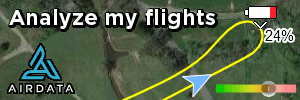Rcdancer,
I like the way you think. Clearly you view practicality being more beneficial to the industry than excessive control.
Your mention of corporations benefitting directly from regulation to the detriment of smaller companies and the population ties directly with recent media reports of corporate players writing new, self serving regulations that are placed in front of Congressional members at both state and federal levels to be rubber stamped into law. That practice is clearly evident in the remote ID NPRM.
In California, PG&E already provides a tracking device for every drone used to inspect power lines. That device transmits a discrete ID, along with constant position data to PG&E’s aviation unit. The device is very small, light, battery powered, and is attached to the outside of a drone with Velcro type material. Transmission range is evidently quite long as I’ve used them well in excess of 40 miles from their aviation group offices. If dedicated data transmission repeater devices were added to existing cell towers the transmission range could be extended enough to be received by area centric receivers for transmission to a central federal location. As electricity and RF signals move at the speed of light any lag in positional accuracy would be minimal.
Conflict with manned aviation would be significantly reduced if the FAA imposed a “hard deck” on manned aviation. With the exception of specific conditions, we (drones) already have a 400’ max operating ceiling. Impose a 500’-600’ AGL hard deck on manned aircraft, including helicopters. Include LEA operations in that limitation. With the exception of take off and landing manned aircraft need not operate at “nap of the earth” levels, and the imaging equipment on law enforcement aircraft is way more than adequate to compensate for a 300’-400’increase in operating altitude. The public would no longer be subjected to disruptive police operation rotor noise as well.
Statistically, manned aviation is far more likely to run into themselves than with us, especially near an airport. If a “sterile” environment was maintained around airports, excepting only those drones equipped with TCAS or ADS-B systems for use in terminal (B, C, and D) areas the risk of a mid air becomes extremely small. Make the penalties for unauthorized operation in terminal areas a federal felony, locally enforceable, with first offense fine structures that would be painful to even wealthy operators.
For informational reference, TCAS was employed on drones in Iraq and Afghanistan with great success. Manned aircraft pilots tended to freak out when seeing a TCAS display representing a drone but there were few actual conflicts. TCAS was simply informing that a drone was in the area, typically on a known flight plan, and never straying into approved manned aircraft airspace. The greatest conflict with drones in “conflict environment” airspace originated with manned helicopter pilots, a group that, for some reason, flies like rules and airspace restrictions don’t apply to them.
In short, corporate aerospace drones have been using remote ID systems for over a decade in wartime environments, and select U.S. airspace, which has been the proving ground in developing the regulations being put in front of us now.





